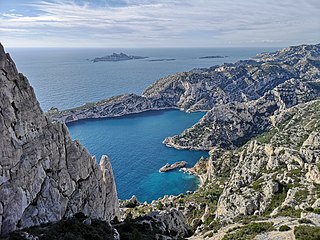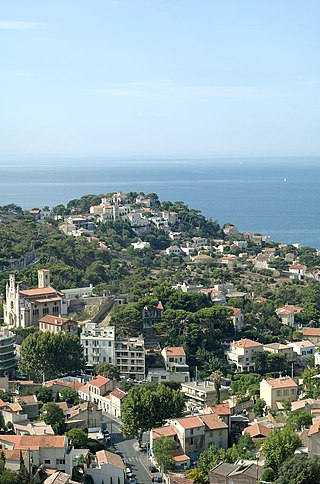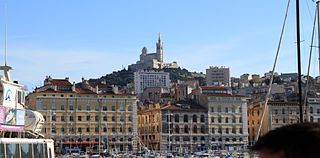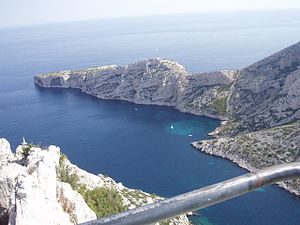
Provence is a geographical region and historical province of southeastern France, which extends from the left bank of the lower Rhône to the west to the Italian border to the east; it is bordered by the Mediterranean Sea to the south. It largely corresponds with the modern administrative region of Provence-Alpes-Côte d'Azur and includes the departments of Var, Bouches-du-Rhône, Alpes-de-Haute-Provence, as well as parts of Alpes-Maritimes and Vaucluse. The largest city of the region and its modern-day capital is Marseille.

A calanque is a narrow, steep-walled inlet that is developed in limestone, dolomite, or other carbonate strata and found along the Mediterranean coast. A calanque is a steep-sided valley formed within karstic regions either by fluvial erosion or the collapse of the roof of a cave that has been subsequently partially submerged by a rise in sea level.

Cassis is a commune situated east of Marseille in the department of Bouches-du-Rhône in the Provence-Alpes-Côte d'Azur region, whose coastline is known in English as the French Riviera, in Southern France.

Cosquer Cave is located in the Calanque de Morgiou in Marseille, France, near Cap Morgiou. The entrance to the cave is located 37 m (121 ft) underwater, due to the Holocene sea level rise. The cave contains various prehistoric rock art engravings. Its submarine entrance was discovered in 1985 by Henri Cosquer, a professional diver. The underwater passage leading to the cave was progressively explored until 1990 by cave divers without the divers being aware of the archaeological character of the cave. It is only in the last period (1990–1991) of the progressive underwater explorations that the cave divers emerged in the non-submerged part of the cave. The prehistoric paintings were not immediately discovered by the divers to first emerge from the other side of the sump. The cave was named after Henri Cosquer, when its existence was made public in 1991, after three divers became lost in the cave and died.

The Calanque de Sugiton is one of the numerous Calanques located between Marseille and Cassis, France.

The Calanque de Sormiou is the largest calanque in Calanques National Park in Southern France. Located within the City of Marseille's 9th arrondissement, it is famous for its climbing spots. Access by car is restricted in the summer due to the risk of forest fires.

The Massif des Calanques is a wild and rugged terrain stretching from the ninth arrondissement of Marseille to the east towards Cassis, spanning 20 km in length and 4 km in width along the coast. Its highest peak is Mont Puget at 565m. The area has been protected by a national park since 2012.

The Sainte-Baume is a mountain ridge spreading between the departments of Bouches-du-Rhône and Var in Southern France. Its summit is 1147 metres high.

Ratonneau is one of the islands of the Frioul archipelago in the Mediterranean Sea, off the southern coast of France near Marseille. It is relatively long and thin, approximately 2.5 km long but at most 500 m wide and generally much narrower. It is connected to the nearby island of Pomègues, which runs roughly parallel, by a mole constructed in 1822 to create a port area.
The Agglomeration community of Pays d'Aubagne et de l'Étoile is a former intercommunal structure joining the communes near Aubagne in the Bouches-du-Rhône and Var departments in the Provence-Alpes-Côte d'Azur region of Southeastern France. It was created in December 1999. On 1 January 2016 it became a territory in the Aix-Marseille-Provence Metropolis.

The Parc du Mugel is a municipal park and botanical garden in the town of La Ciotat, in the French department of Bouches-du-Rhône, on the Mediterranean coast of France between Marseille and Toulon. It is listed among the Remarkable Gardens of France by the French Ministry of Culture.

Bompard is a quarter in the 7th arrondissement of Marseille, France. According to the 2012 INSEE census, it had a population of 4,220.
Baumettes Prison is a prison in the 9th arrondissement of Marseille.

The 9th arrondissement of Marseille is one of 16 arrondissements of Marseille. This district is the largest in the city. The 9th arrondissement borders the 8th, 10th and 11th arrondissements. It is governed locally together with the 10th arrondissement, with which it forms the 5th sector of Marseille.

Cap Canaille is a headland in Calanques National Park in the Bouches-du-Rhône department in Southern France, on the Mediterranean coast between the towns of Cassis and La Ciotat. It is about 27 km (16 mi) southeast of the city centre of Marseille. At 394 m (1,293 ft), it is the highest sea cliff of France.

Calanques National Park is a French national park located on the Mediterranean coast in Bouches-du-Rhône, Southern France. It was established in 2012 and extends over 520 km2 (201 sq mi), of which 85 km2 (33 sq mi) is land, while the remaining is marine area. It includes parts of the Massif des Calanques stretching between Marseille's southern arrondissements, Cassis and La Ciotat. Some of the park's best known features include the Calanque de Sormiou, Calanque de Morgiou, Calanque de Port-Miou, Calanque de Sugiton, Calanque d'en Vau and Cosquer Cave.

Marseille or Marseilles is the prefecture of the French department of Bouches-du-Rhône and of the Provence-Alpes-Côte d'Azur region. Situated in the Provence region of southern France, it is located on the coast of the Gulf of Lion, part of the Mediterranean Sea, near the mouth of the Rhône river. A resident of Marseille is a Marseillais.

Mazargues is a former village and now a neighbourhood of the 9th arrondissement in Marseille, Bouches-du-Rhône, France.
Belsunce is a district near Canebière, central Marseille. Its name was given by Monseigneur Henri François Xavier de Belsunce de Castelmoron, who famously helped during the Great Plague of Marseille.

The Vallon des Auffes is a little traditional fishing haven in Marseille in the 7th arrondissement of Marseille. It is situated 2.5 km south-west of the Vieux-Port over the Corniche Kennedy, between the Catalans beach and Malmousque bay.


















